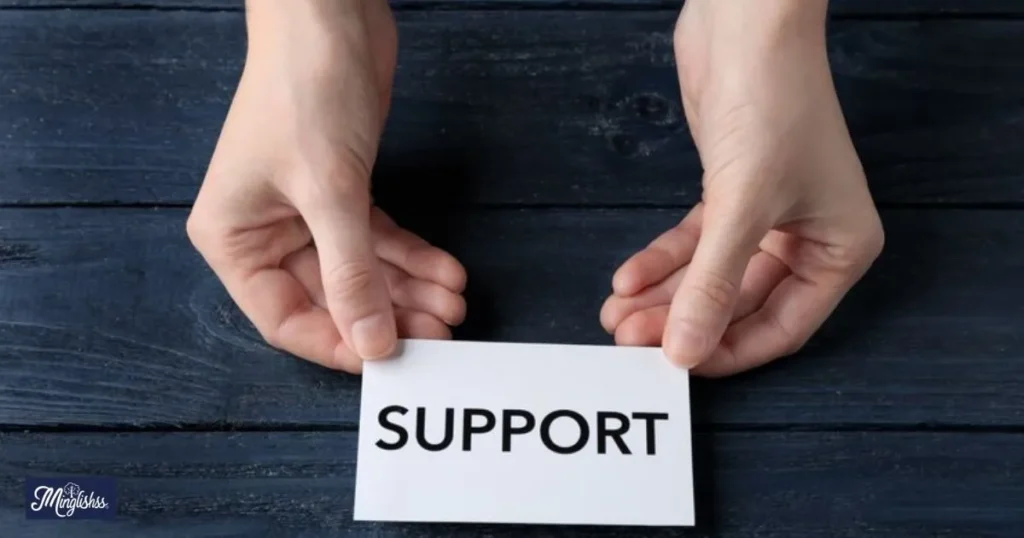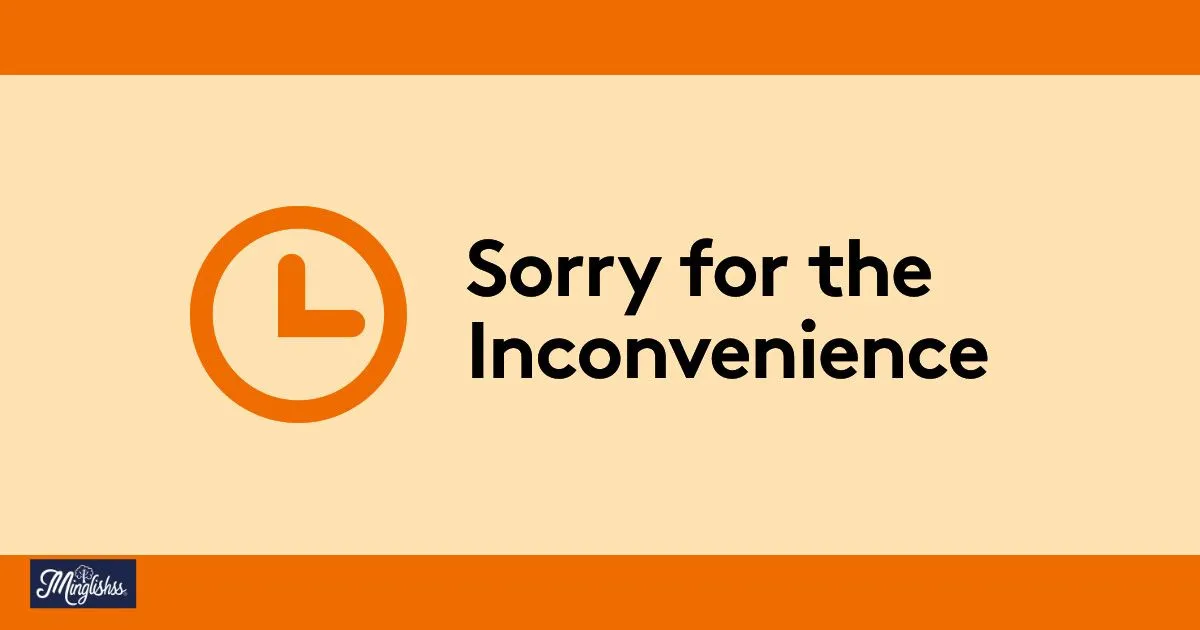“Finding the right words can turn a mistake into an opportunity.”
In our daily interactions, it’s common to face situations that lead to inconvenience for others. Whether it’s a delayed response, a missed appointment, or a mistake in service, expressing regret is crucial in maintaining good relationships. Saying “sorry for the inconvenience” is a standard phrase, but using alternative expressions can enhance your communication and convey sincerity.
A thoughtful apology not only acknowledges the inconvenience caused but also shows respect for the other person’s feelings. Choosing the right words can make a significant difference in how your message is received. The alternatives provided here will help you articulate your sentiments more effectively.
In this blog, we’ll explore 35 different ways to say “sorry for the inconvenience,” each paired with a scenario and additional insights. By diversifying your vocabulary, you can ensure your apologies are both sincere and appropriate for the context.
1. I Apologize for the Trouble
Scenario: You missed a deadline for a project at work.
Explanation: This phrase acknowledges the difficulty you may have caused someone and expresses regret.
Additional Tip: Use this in formal contexts to maintain professionalism.
2. I Regret the Inconvenience Caused
Scenario: A customer received the wrong order.
Explanation: This statement emphasizes your regret and acknowledges the disruption.
Additional Tip: Best suited for customer service interactions to show empathy.
3. I’m Sorry for the Disruption

Scenario: A scheduled meeting was canceled at the last minute.
Explanation: This phrase conveys your acknowledgment of the interruption and its impact.
Additional Tip: Use it when addressing a group to maintain a professional tone.
4. I Appreciate Your Understanding
Scenario: There was a delay in responding to a client’s email.
Explanation: This phrase thanks the other person for their patience while also expressing regret.
Additional Tip: Use this to reinforce positive relationships, especially in professional settings.
5. Thank You for Your Patience
Scenario: You took longer than expected to resolve an issue.
Explanation: This phrase acknowledges the inconvenience while also expressing gratitude for the other person’s understanding.
Additional Tip: Best used when you want to soften the apology and highlight the positive attitude of the other person.
6. I’m Sorry for Any Inconvenience This May Have Caused
Scenario: A service outage affected multiple customers.
Explanation: This phrase addresses the potential impact of your actions on others.
Additional Tip: Ideal for public statements where a broader audience is involved.
7. I Apologize for Any Confusion
Scenario: Miscommunication occurred regarding a project deadline.
Explanation: This statement acknowledges that misunderstanding can lead to inconvenience.
Additional Tip: Use this to clarify misunderstandings and improve communication in the future.
8. I Understand This is Frustrating
Scenario: A client is upset about a product malfunction.
Explanation: This phrase validates the other person’s feelings while expressing regret.
Additional Tip: Use this to build rapport by showing empathy.
9. I’m Sorry for the Delay
Scenario: There was a wait for a product shipment.
Explanation: This phrase directly addresses the inconvenience of time lost.
Additional Tip: Effective in both personal and professional contexts when discussing delays.
10. I Appreciate Your Flexibility
Scenario: You changed plans at the last minute.
Explanation: This phrase recognizes the other person’s ability to adapt.
Additional Tip: Use this to reinforce positive relationships, particularly in team settings.
11. I’m Here to Help
Scenario: A customer expresses frustration with a service issue.
Explanation: This phrase shifts the focus from the apology to how you can assist moving forward.
Additional Tip: Effective for customer service situations to convey support.
12. Please Accept My Apology
Scenario: You need to address a mistake made in a report.
Explanation: This phrase offers a direct and formal acknowledgment of the mistake.
Additional Tip: Ideal for professional settings to convey sincerity.
13. I’m Sorry for the Oversight
Scenario: You forgot to send important information.
Explanation: This phrase specifically addresses the mistake while acknowledging its impact.
Additional Tip: Use it to take responsibility clearly and directly.
14. I’ll Make It Right

Scenario: A service issue needs correction.
Explanation: This phrase indicates your commitment to resolving the problem.
Additional Tip: Use it to assure the other person that you are taking actionable steps.
15. I Appreciate Your Feedback
Scenario: A customer provides criticism regarding a service.
Explanation: This phrase shows that you value the other person’s input, even when it points out flaws.
Additional Tip: Use this to foster a constructive dialogue.
16. I’m Sorry for Any Misunderstanding
Scenario: A miscommunication caused issues in a project.
Explanation: This phrase addresses the issue without placing blame.
Additional Tip: Ideal when you want to clear the air while remaining diplomatic.
17. I Apologize for the Mistake
Scenario: An error in a report needs addressing.
Explanation: This direct phrase acknowledges a mistake clearly and concisely.
Additional Tip: Use it in formal settings to express accountability.
18. I’m Sorry for Any Disappointment
Scenario: A service didn’t meet expectations.
Explanation: This phrase acknowledges feelings of letdown while expressing regret.
Additional Tip: Effective in situations where customer satisfaction is key.
19. I Value Your Time
Scenario: A meeting ran longer than expected.
Explanation: This phrase shows respect for the other person’s time and acknowledges the inconvenience.
Additional Tip: Use it to reinforce professionalism in workplace settings.
20. I’ll Ensure This Doesn’t Happen Again
Scenario: A repeated issue occurred with a client.
Explanation: This phrase emphasizes your commitment to improvement and responsibility.
Additional Tip: Best used when discussing issues that need addressing to prevent future occurrences.
Other Ways to Say “Keep Me in the Loop”
21. Thank You for Your Understanding
Scenario: A colleague dealt with a last-minute change.
Explanation: This phrase acknowledges the inconvenience while showing gratitude.
Additional Tip: Ideal for fostering goodwill in professional relationships.
22. I’m Grateful for Your Patience
Scenario: A customer waited for a resolution.
Explanation: This phrase expresses appreciation while acknowledging the inconvenience.
Additional Tip: Use this to strengthen rapport after a service hiccup.
23. I’m Sorry for the Oversight
Scenario: You missed including someone in a project.
Explanation: This phrase specifically addresses the mistake while acknowledging its impact.
Additional Tip: Use it to show accountability and a commitment to improvement.
24. I Understand Your Frustration
Scenario: A client is upset about a service error.
Explanation: This phrase acknowledges the feelings of the other person and shows empathy.
Additional Tip: Use this to create a connection and alleviate tension.
25. I’m Here to Support You

Scenario: A colleague is struggling with a workload issue.
Explanation: This phrase shifts the focus from the inconvenience to how you can assist.
Additional Tip: Effective in team environments where collaboration is key.
26. I Value Your Feedback
Scenario: A client expresses dissatisfaction with a service.
Explanation: This phrase shows that you appreciate the other person’s input and are open to improvement.
Additional Tip: Use this to foster a culture of continuous improvement.
27. I’m Sorry for the Delay in Response
Scenario: You took time to reply to an important email.
Explanation: This phrase directly addresses the time lost in communication.
Additional Tip: Use this when addressing communication issues to show accountability.
28. I Hope You Can Forgive Me
Scenario: A friend feels let down by your actions.
Explanation: This phrase expresses a desire for reconciliation while acknowledging the hurt caused.
Additional Tip: Best used in personal relationships to convey sincerity.
29. I’ll Ensure This is Resolved Quickly
Scenario: A service issue has been raised by a client.
Explanation: This phrase assures the other person that action will be taken to fix the problem.
Additional Tip: Use this to instill confidence in your ability to address concerns.
30. I’m Sorry for Not Meeting Your Expectations
Scenario: A customer expected better service quality from your business.
Explanation: This phrase directly addresses the feelings of disappointment. It shows you recognize that the other party’s expectations were higher and that you did not deliver. It’s an effective way to acknowledge their experience without being overly formal or stiff.
Additional Tip: This apology works best when followed by an action plan to ensure improvements. It’s important to not only acknowledge but also to show that steps are being taken to prevent a repeat.
31. Please Bear With Me
Scenario: You are running behind on a project and need more time.
Explanation: This is a polite way of asking for understanding while acknowledging that the delay may have caused frustration. It’s not a direct apology but conveys empathy and a desire for patience from the other party.
Additional Tip: This phrase is particularly useful when dealing with ongoing issues that cannot be resolved immediately. You can enhance its impact by providing an estimated time of resolution.
32. I Regret Any Inconvenience This Has Caused You
Scenario: Your team delivered a product late, inconveniencing the client.
Explanation: This formal apology acknowledges that the situation has impacted the other party and expresses a sense of regret for causing trouble. It’s particularly appropriate in professional emails or reports when addressing a significant lapse.
Additional Tip: After offering this apology, be sure to outline the steps you will take to make up for the inconvenience or prevent it from happening again.
33. I Apologize for the Short Notice
Scenario: You’ve informed a colleague or friend about a last-minute schedule change.
Explanation: This statement recognizes that the timing of your message could cause stress or difficulty for the other party. It’s a respectful way to take ownership of the late notice while expressing regret.
Additional Tip: Offering a solution or alternative, like rescheduling or providing extra assistance, can strengthen the apology.
34. I’m Sorry for Any Discomfort This Has Caused

Scenario: A service interruption left customers with limited access to essential services.
Explanation: This phrase is ideal when the inconvenience has affected the comfort or ease of the other party. It shows concern and empathy, especially when physical or mental discomfort might have occurred.
Additional Tip: Follow this up with clear communication about how you’re working to prevent similar situations in the future. Assurance plays a key role here.
35. I Apologize for Any Setbacks This May Have Created
Scenario: A project delay resulted in issues for another department or partner.
Explanation: This phrase acknowledges that your actions, or lack thereof, may have caused disruptions or delays in the other party’s plans. It’s important to show that you are aware of the consequences and are committed to resolving them.
Additional Tip: It’s essential to provide a timeframe or detailed plan for resolution after delivering this apology, to show accountability and forward thinking.
1. Why is it important to use different ways to apologize?
Using varied language helps convey sincerity and avoids sounding repetitive or insincere, making your apology more effective.
2. When should I use formal apology phrases?
Formal apologies are best suited for professional or business settings, where respect and accountability are key.
3. Can these alternatives be used in personal situations?
Yes, many of these alternatives are adaptable to both personal and professional scenarios, depending on the context.
4. What makes a good apology?
A good apology is sincere, acknowledges the issue, and offers a plan or solution to fix the problem or prevent it from happening again.
5. How do I know which apology to use in a specific situation?
Consider the severity of the inconvenience and the relationship with the other party. Formal apologies are suitable for professional contexts, while casual phrases may work better in personal situations.
Conclusion
Apologizing effectively is more than just saying “sorry for the inconvenience.” Using varied and thoughtful phrases can help convey sincerity and understanding, making your apologies more personal and impactful. Whether you’re dealing with customers, colleagues, or friends, offering a well-considered apology that fits the situation can make a big difference.
These 35 alternatives provide you with a toolkit of responses to keep your communication empathetic and professional.

Hi, I’m Zadie Smith: I’m dedicated to helping others master English through practical tips. I enjoy making complex ideas simple and accessible for everyone.










